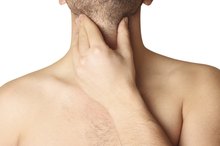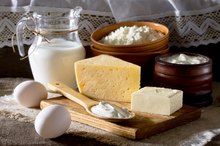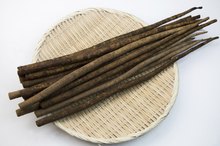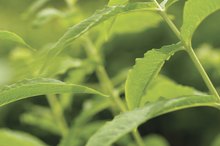What does fact checked mean?
At Healthfully, we strive to deliver objective content that is accurate and up-to-date. Our team periodically reviews articles in order to ensure content quality. The sources cited below consist of evidence from peer-reviewed journals, prominent medical organizations, academic associations, and government data.
The information contained on this site is for informational purposes only, and should not be used as a substitute for the advice of a professional health care provider. Please check with the appropriate physician regarding health questions and concerns. Although we strive to deliver accurate and up-to-date information, no guarantee to that effect is made.
Side Effects of Deglycyrrhizinated Licorice
If you have a stomach or peptic ulcer, you may benefit from taking a daily supplement called deglycyrrhizinated licorice. This natural supplement is derived from root of the licorice plant and is administered orally. Consult your medical provider if you have any questions or concerns regarding the potential side effects of deglycyrrhizinated licorice supplements 3.
If you are experiencing serious medical symptoms, seek emergency treatment immediately.
No Adverse Effects
Unlike licorice supplements, deglycyrrhizinated licorice is not associated with any adverse side effects as of December 2010; however, clinical studies evaluating the safety of this supplement are lacking. If you experience health problems while taking this supplement, contact your primary medical provider for further evaluation and care.
Contraindications
Levothyroxine & High Fiber Diet
Learn More
Women who are pregnant or nursing should not take supplements that contain licorice, the University of Maryland Medical Center reports 123. Additionally, people who have kidney or liver damage or disease should avoid taking licorice-containing supplements unless otherwise directed by a physician. Treatment with deglycyrrhizinated licorice is intended to be on a short-term basis and should not exceed 4 to 6 weeks.
- Women who are pregnant or nursing should not take supplements that contain licorice, the University of Maryland Medical Center reports 1.
- Additionally, people who have kidney or liver damage or disease should avoid taking licorice-containing supplements unless otherwise directed by a physician.
Medication Interactions
Talk with your medical provider about any medications you are currently taking before beginning treatment with deglycyrrhizinated licorice 3. Concomitant use of licorice and coumadin, a blood thinner, may increase your risk of developing blood clots, MedlinePlus explains. Additional medications to discuss with your doctor include:
- diuretics
- corticosteroids
- ACE inhibitors
- insulin or diabetes drugs
- laxative
- MAO inhibitors
- digoxin
- oral contraceptives
Related Articles
References
- University of Maryland Medical Center: Licorice
- Memorial Sloan-Kettering Medical Center: Licorice
- NYU Lagone Medical Center: Licorice
- NIH National Center for Complementary and Integrative Health. Licorice root. Updated December 1, 2016.
- Raveendra KR, Jayachandra, Srinivasa V, et al. An extract of glycyrrhiza glabra (GutGard)alleviates symptoms of functional dyspepsia: a randomized, double-blind, placebo-controlled study. Evidence-Based Complementary and Alternative Medicine. 2012;2012:1-9. doi:10.1155/2012/216970
- Messier C, Epifano F, Genovese S, Grenier D. Licorice and its potential beneficial effects in common oro-dental diseases. Oral Dis. 2012;18(1):32-39. doi:10.1111/j.1601-0825.2011.01842.x
- Shi Q, Hou Y, Yang Y, Bai G. Protective effects of glycyrrhizin against β2-adrenergic receptor agonist-induced receptor internalization and cell apoptosis. Biol. Pharm. Bull. 2011;34(5):609-617. doi:10.1248/bpb.34.609
- Tsao S, Yin M. Antioxidative and antiinflammatory activities of asiatic acid, glycyrrhizic Acid, and oleanolic acid in human bronchial epithelial cells. J. Agric. Food Chem. 2015;63(12):3196-3204.
- Zhao H, Zhang X, Chen X, et al. Isoliquiritigenin, a flavonoid from licorice, blocks M2 macrophage polarization in colitis-associated tumorigenesis through downregulating PGE2 and IL-6. Toxicology and Applied Pharmacology. 2014;279(3):311-321. doi:10.1016/j.taap.2014.07.001
- Nahidi F, Zare E, Mojab F, Alavi-Majd H. Effects of licorice on relief and recurrence of menopausal hot flashes. Iranian Journal of Pharmaceutical Research: IJPR. 2012;11(2):541-8.
- Hajiaghamohammadi AA, Zargar A, Oveisi S, Samimi R, Reisian S. To evaluate of the effect of adding licorice to the standard treatment regimen of helicobacter pylori. The Brazilian Journal of Infectious Diseases. 2016;20(6):534-538. doi: 10.1016/j.bjid.2016.07.015
- Irani M, Sarmadi M, Bernard F, Ebrahimi Pour GH, Shaker Bazarnov H. Leaves antimicrobial activity of Glycyrrhiza glabra L. Iranian Journal of Pharmaceutical Research: IJPR. 2010;9(4):425-8.
- Penn State Hershey Milton S. Hershey Medical Center. Licorice.
- Omar HR, Komarova I, El-Ghonemi M, et al. Licorice abuse: time to send a warning message. Therapeutic Advances in Endocrinology. 2012;3(4):125-138. doi:10.1177/2042018812454322
- Räikkönen K, Martikainen S, Pesonen A, et al. Maternal licorice consumption during pregnancy and pubertal, cognitive, and psychiatric outcomes in children. Am J Epidemiol. 2017;185(5):317-328. doi:10.1093/aje/kww172
- Consumer Reports. Food and drug interactions you need to know about. Updated November 4, 2018.
- Winchester Hospital. Library. Updated April 11, 2011.
- Consumer Reports. How to choose supplements wisely. Updated October 30, 2019.
- FDA. Black licorice: Trick or treat? Updated November 6, 2017.
Writer Bio
Rae Uddin has worked as a freelance writer and editor since 2004. She specializes in scientific journalism and medical and technical writing. Her work has appeared in various online publications. Uddin earned her Master of Science in integrated biomedical sciences with an emphasis in molecular and cellular biochemistry from the University of Kentucky College of Medicine.









